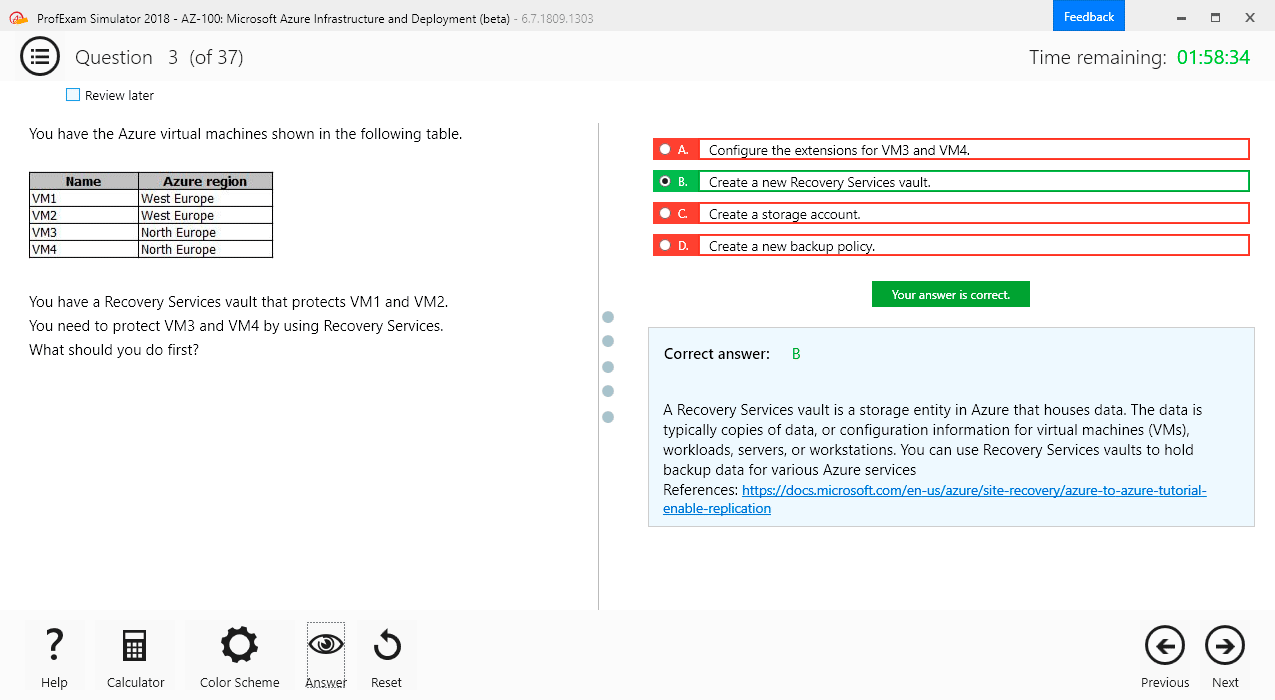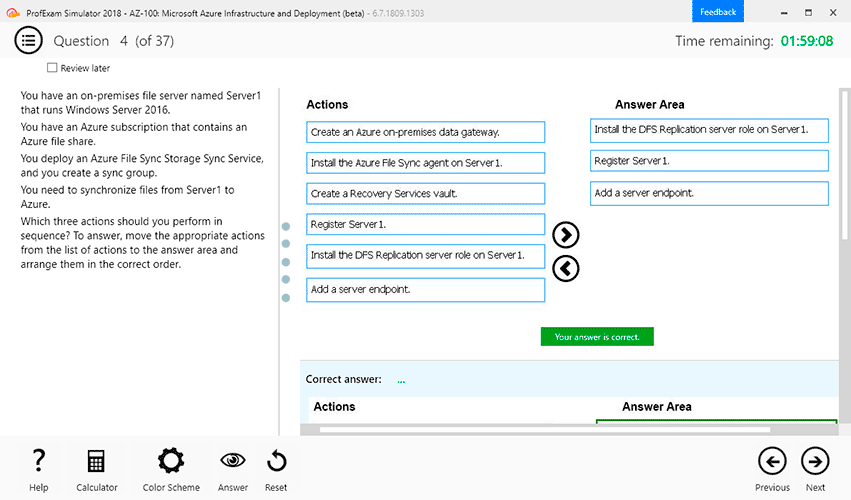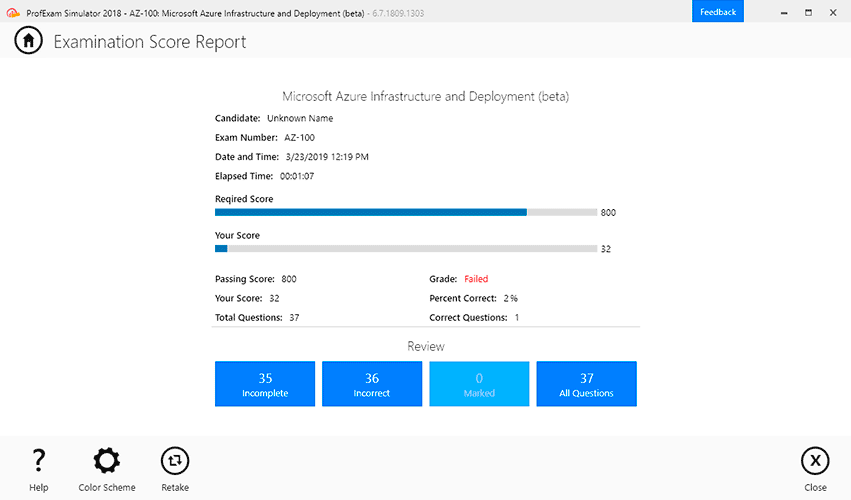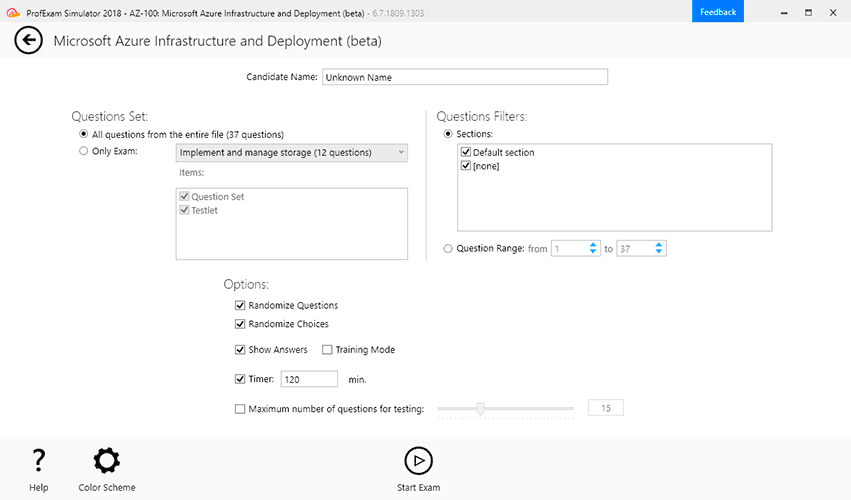File Info
| Exam | SnowPro-Core |
| Number | SnowPro-Core |
| File Name | Snowflake.SnowPro-Core.VCEplus.2024-11-08.52q.vcex |
| Size | 38 KB |
| Posted | Nov 08, 2024 |
| Download | Snowflake.SnowPro-Core.VCEplus.2024-11-08.52q.vcex |
How to open VCEX & EXAM Files?
Files with VCEX & EXAM extensions can be opened by ProfExam Simulator.
Coupon: MASTEREXAM
With discount: 20%





Demo Questions
Question 1
What computer language can be selected when creating User-Defined Functions (UDFs) using the Snowpark API?
- Swift
- JavaScript
- Python
- SQL
Correct answer: C
Explanation:
The Snowpark API allows developers to create User-Defined Functions (UDFs) in various languages, including Python, which is known for its ease of use and wide adoption in data-related tasks.Reference:Based on general programming and cloud data service knowledge as of 2021. The Snowpark API allows developers to create User-Defined Functions (UDFs) in various languages, including Python, which is known for its ease of use and wide adoption in data-related tasks.Reference:Based on general programming and cloud data service knowledge as of 2021.
Question 2
What is the name of the SnowSQLfile that can store connection information?
- history
- config
- snowsqLcnf
- snowsql.pubkey
Correct answer: B
Explanation:
The SnowSQL file that can store connection information is named 'config'. It is used to store user credentials and connection details for easy access to Snowflake instances.Reference:Based on general database knowledge as of 2021. The SnowSQL file that can store connection information is named 'config'. It is used to store user credentials and connection details for easy access to Snowflake instances.Reference:Based on general database knowledge as of 2021.
Question 3
In which Snowflake layer does Snowflake reorganize data into its internal optimized, compressed, columnar format?
- Cloud Services
- Database Storage
- Query Processing
- Metadata Management
Correct answer: B
Explanation:
Snowflake reorganizes data into its internal optimized, compressed, columnar format in the Database Storage layer.This process is part of how Snowflake manages data storage, ensuring efficient data retrieval and query performance Snowflake reorganizes data into its internal optimized, compressed, columnar format in the Database Storage layer.This process is part of how Snowflake manages data storage, ensuring efficient data retrieval and query performance
Question 4
A developer is granted ownership of a table that has a masking policy. The developer's role is not able to see the masked data. Will the developer be able to modify the table to read the masked data?
- Yes, because a table owner has full control and can unset masking policies.
- Yes, because masking policies only apply to cloned tables.
- No, because masking policies must always reference specific access roles.
- No, because ownership of a table does not include the ability to change masking policies
Correct answer: D
Explanation:
Even if a developer is granted ownership of a table with a masking policy, they will not be able to modify the table to read the masked data if their role does not have the necessary permissions. Ownership of a table does not automatically confer the ability to alter masking policies, which are designed to protect sensitive data.Masking policies are applied at the schema level and require specific privileges to modify12.[COF-C02] SnowPro Core Certification Exam Study GuideSnowflake Documentation on Masking Policies Even if a developer is granted ownership of a table with a masking policy, they will not be able to modify the table to read the masked data if their role does not have the necessary permissions. Ownership of a table does not automatically confer the ability to alter masking policies, which are designed to protect sensitive data.Masking policies are applied at the schema level and require specific privileges to modify12.
[COF-C02] SnowPro Core Certification Exam Study Guide
Snowflake Documentation on Masking Policies
Question 5
What is the MOST performant file format for loading data in Snowflake?
- CSV (Unzipped)
- Parquet
- CSV (Gzipped)
- ORC
Correct answer: B
Explanation:
Parquet is a columnar storage file format that is optimized for performance in Snowflake. It is designed to be efficient for both storage and query performance, particularly for complex queries on large datasets. Parquet files support efficient compression and encoding schemes, which can lead to significant savings in storage and speed in query processing, making it the most performant file format for loading data into Snowflake.[COF-C02] SnowPro Core Certification Exam Study GuideSnowflake Documentation on Data Loading1 Parquet is a columnar storage file format that is optimized for performance in Snowflake. It is designed to be efficient for both storage and query performance, particularly for complex queries on large datasets. Parquet files support efficient compression and encoding schemes, which can lead to significant savings in storage and speed in query processing, making it the most performant file format for loading data into Snowflake.
[COF-C02] SnowPro Core Certification Exam Study Guide
Snowflake Documentation on Data Loading1
Question 6
The Information Schema and Account Usage Share provide storage information for which of the following objects? (Choose three.)
- Users
- Tables
- Databases
- Internal Stages
Correct answer: BCD
Explanation:
The Information Schema and Account Usage Share in Snowflake provide metadata and historical usage data for various objects within a Snowflake account. Specifically, they offer storage information forTables,Databases, andInternal Stages. These schemas contain views and table functions that allow users to query object metadata and usage metrics, such as the amount of data stored and historical activity.Tables: The storage information includes data on the daily average amount of data in database tables.Databases: For databases, the storage usage is calculated based on all the data contained within the database, including tables and stages.Internal Stages: Internal stages are locations within Snowflake for temporarily storing data, and their storage usage is also tracked. The Information Schema and Account Usage Share in Snowflake provide metadata and historical usage data for various objects within a Snowflake account. Specifically, they offer storage information forTables,Databases, andInternal Stages. These schemas contain views and table functions that allow users to query object metadata and usage metrics, such as the amount of data stored and historical activity.
Tables: The storage information includes data on the daily average amount of data in database tables.
Databases: For databases, the storage usage is calculated based on all the data contained within the database, including tables and stages.
Internal Stages: Internal stages are locations within Snowflake for temporarily storing data, and their storage usage is also tracked.
Question 7
True or False: Reader Accounts are able to extract data from shared data objects for use outside of Snowflake.
- True
- False
Correct answer: B
Explanation:
Reader accounts in Snowflake are designed to allow users to read data shared with them but do not have the capability to extract data for use outside of Snowflake. They are intended for consuming shared data within the Snowflake environment only. Reader accounts in Snowflake are designed to allow users to read data shared with them but do not have the capability to extract data for use outside of Snowflake. They are intended for consuming shared data within the Snowflake environment only.
Question 8
True or False: Fail-safe can be disabled within a Snowflake account.
- True
- False
Correct answer: B
Explanation:
Separate and distinct from Time Travel, Fail-safe ensures historical data is protected in the event of a system failure or other catastrophic event, e.g. a hardware failure or security breach. Fail-safe feature cannot be enabled or disabled from the user end. Separate and distinct from Time Travel, Fail-safe ensures historical data is protected in the event of a system failure or other catastrophic event, e.g. a hardware failure or security breach. Fail-safe feature cannot be enabled or disabled from the user end.
Question 9
A virtual warehouse's auto-suspend and auto-resume settings apply to which of the following?
- The primary cluster in the virtual warehouse
- The entire virtual warehouse
- The database in which the virtual warehouse resides
- The Queries currently being run on the virtual warehouse
Correct answer: B
Explanation:
The auto-suspend and auto-resume settings in Snowflake apply to the entire virtual warehouse. These settings allow the warehouse to automatically suspend when it's not in use, helping to save on compute costs. When queries or tasks are submitted to the warehouse, it can automatically resume operation. This functionality is designed to optimize resource usage and cost-efficiency.SnowPro Core Certification Exam Study Guide (as of 2021)Snowflake documentation on virtual warehouses and their settings (as of 2021) The auto-suspend and auto-resume settings in Snowflake apply to the entire virtual warehouse. These settings allow the warehouse to automatically suspend when it's not in use, helping to save on compute costs. When queries or tasks are submitted to the warehouse, it can automatically resume operation. This functionality is designed to optimize resource usage and cost-efficiency.
SnowPro Core Certification Exam Study Guide (as of 2021)
Snowflake documentation on virtual warehouses and their settings (as of 2021)
Question 10
What happens to the underlying table data when a CLUSTER BY clause is added to a Snowflake table?
- Data is hashed by the cluster key to facilitate fast searches for common data values
- Larger micro-partitions are created for common data values to reduce the number of partitions that must be scanned
- Smaller micro-partitions are created for common data values to allow for more parallelism
- Data may be colocated by the cluster key within the micro-partitions to improve pruning performance
Correct answer: D
Explanation:
When aCLUSTER BYclause is added to a Snowflake table, it specifies one or more columns to organize the data within the table's micro-partitions. This clustering aims to colocate data with similar values in the same or adjacent micro-partitions. By doing so, it enhances the efficiency of query pruning, where the Snowflake query optimizer can skip over irrelevant micro-partitions that do not contain the data relevant to the query, thereby improving performance.Snowflake Documentation on Clustering Keys & Clustered Tables1.Community discussions on how source data's ordering affects a table with a cluster key When aCLUSTER BYclause is added to a Snowflake table, it specifies one or more columns to organize the data within the table's micro-partitions. This clustering aims to colocate data with similar values in the same or adjacent micro-partitions. By doing so, it enhances the efficiency of query pruning, where the Snowflake query optimizer can skip over irrelevant micro-partitions that do not contain the data relevant to the query, thereby improving performance.
Snowflake Documentation on Clustering Keys & Clustered Tables1.
Community discussions on how source data's ordering affects a table with a cluster key

